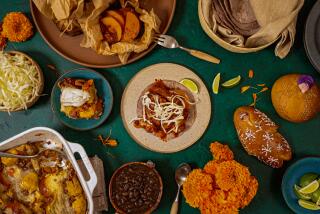This Bud’s for Use: Get to Know the Artichoke
When I first encountered an artichoke, I felt intimidated by the green flower bud. But I realized that artichokes are fun to eat and, though they might appear to be encased in armor, they actually are simple to prepare.
Before cooking artichokes, you cut off their tops and snip off the spiky tips of the remaining leaves. Then you boil or steam them.
To eat one, pull off a leaf, dip its bottom in sauce if you like and scrape the meat from the leaf’s base with your teeth. When you’ve finished the leaves, you come to a cone of thin purple leaves, which you discard. Under them is the fuzzy, inedible choke. Pull it out or scrape it off with a spoon. What’s left is the prized artichoke bottom, often called the heart, which you can eat with the same sauce you’ve used on the leaves.
Cook extra artichokes so you’ll have the hearts for other recipes--if you can resist eating them immediately. They’re terrific in salads, pasta dishes and stews.
Choose compact artichokes that feel heavy for their size, with their leaves (technically bracts) closed, firm and not dry. I go for those with as much stem as possible. The peeled stems have the same flavor and texture as the hearts, and I cringe when I see people throw them away.
Large artichokes are impressive and have big hearts, but small or medium ones cook faster and need little trimming. You can keep artichokes unwashed in the refrigerator up to five days.
Both delicate and assertive tastes complement artichokes. Some people prefer thick dips they can lift on a leaf, such as buttery hollandaise sauce or aioli, the Provencal garlic mayonnaise. Others like to dunk each leaf in melted butter or vinaigrette. In France the vinaigrette might be tangy with mustard or subtly seasoned with walnut oil and wine vinegar, in Italy accented with capers and olives, in Greece flavored with olive oil, lemon juice and dill and in California peppered with chiles. Fresh herbs, diced roasted peppers or chopped sun-dried tomatoes make tasty additions to any of these dips.
Don’t try to match artichokes with wine; they have a peculiar attribute of making it taste funny. And enjoy this sensuous symbol of spring as the starter for a relaxing dinner, not when you’re rushed or ravenous.
*
Faye Levy is the author of the James Beard Award-winning “Faye Levy’s International Vegetable Cookbook” (Warner, 1993).
*
Artichokes With Two Sauces
Active Work Time: 20 minutes * Total Preparation Time: 1 hour * Vegetarian
Serve your artichokes with Mustard Vinaigrette and Chipotle Chile Dip or with a double recipe of either one. Chipotle chiles are smoked jalapenos that you can buy canned in adobo sauce at well-stocked supermarkets and Latino markets. For variations, use minced fresh or canned jalapenos, Indonesian sambal oelek, North African harissa or any kind of hot pepper sauce you like. This recipe allows generous amounts of the sauces (about 2/3 cup of each sauce) in case you want to serve them in individual bowls. You can cook the artichokes and prepare the dips up to 2 days ahead.
*
ARTICHOKES
4 medium or large artichokes or 8 small or 12 baby artichokes
Salt
Baby artichokes don’t need trimming. With the other artichokes, cut off the top quarter, about 1 inch of large or 1/2 inch of small ones, using a sharp, heavy knife or a serrated knife. Trim the spikes from the tips of the leaves with scissors. With baby artichokes, leave the stems attached. With others, cut off the stems and peel off their fibrous outer layer with a paring knife. Wash your hands and the board after handling raw artichokes, or the next foods you handle or cut will have a funny taste.
Place the artichokes and stems in a large saucepan of boiling salted water and cover with a lid of slightly smaller diameter to keep them submerged. Cook over medium heat until a leaf near the bottom can be easily pulled out, but don’t cook them until mushy. Small ones need about 15 to 20 minutes, medium ones about 25 to 35 and large artichokes about 45 minutes.
Using tongs, remove the artichokes and set them upside down in a colander to drain. (Don’t save the cooking liquid; it doesn’t taste good.)
Either cover them to keep them warm, or let them cool and serve them at room temperature or chilled. Accompany them with bowls of dipping sauce.
*
MUSTARD VINAIGRETTE
2 tablespoons Dijon mustard
3 tablespoons white or red wine vinegar
Salt
Freshly ground pepper
1/2 cup oil, plus 1 more tablespoon if needed
1 tablespoon minced shallot or 2 tablespoons minced green onion
2 tablespoons chopped parsley
Whisk the mustard in a bowl with the vinegar, and salt and pepper to taste. Gradually whisk in 1/2 cup of oil. Taste, and add more oil if the dressing is too sharp. Stir in the shallot and parsley. Taste and adjust the seasoning. Whisk again before serving.
*
CHIPOTLE CHILE DIP
2 large cloves garlic, chopped, or 1 to 2 tablespoons chopped garlic chives
1 to 2 tablespoons strained lime or lemon juice, or more to taste
1 or 2 canned chipotle chiles in adobo sauce, 1 to 2 tablespoons chipotle salsa from a jar or 1 teaspoon liquid hot sauce, or to taste
2/3 cup mayonnaise, reduced-fat or regular
Salt
3 tablespoons chopped cilantro, optional
Blend the garlic (but not the garlic chives) and the lime juice in a food processor. Remove 1 chile from its adobo sauce, add the chile to the processor and blend it to a puree. Add the mayonnaise and process until blended. Taste; if you want more heat, add 1 teaspoon of the adobo sauce or dice another chile, add it to the sauce and process until well blended. Transfer the dip to a bowl. Add salt and more lime juice if needed. Add the cilantro and the garlic chives, if using.
4 servings. Each serving: 471 calories; 871 mg sodium; 10 mg cholesterol; 40 grams fat; 4 grams saturated fat; 26 grams carbohydrates; 4 grams protein; 6.37 grams fiber.


